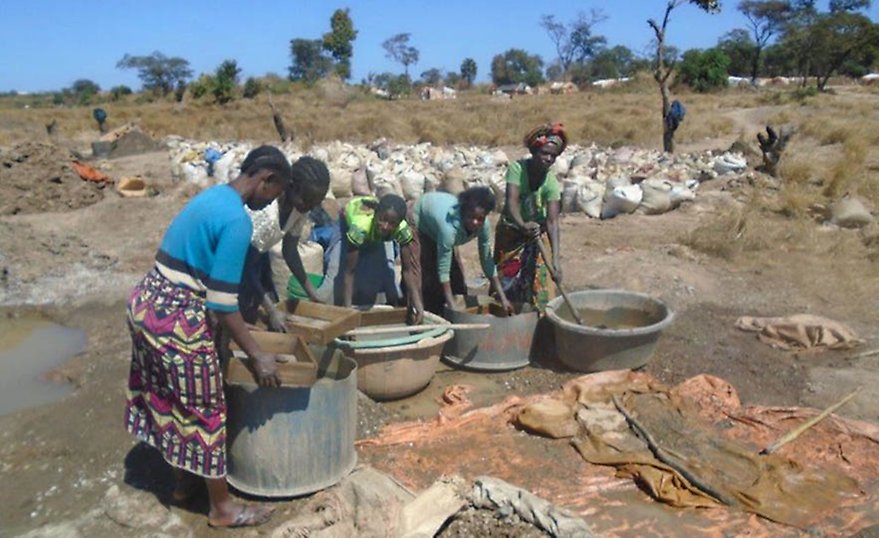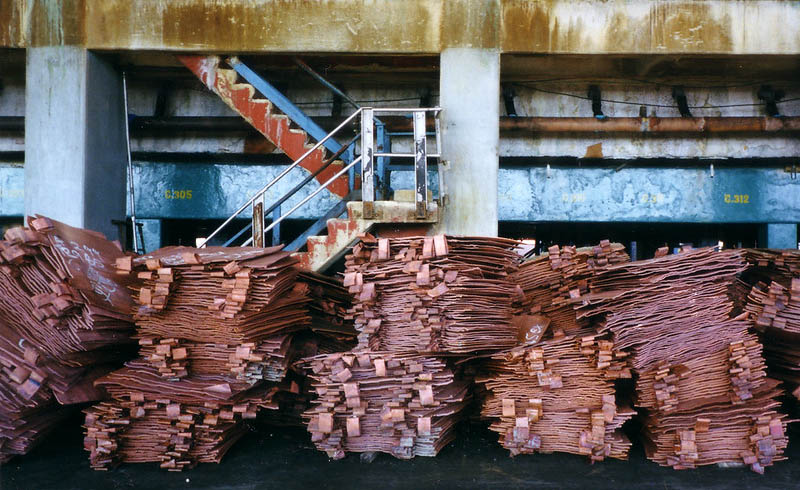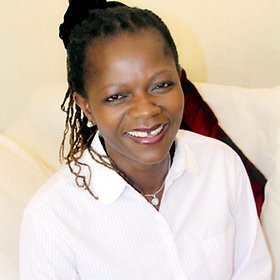Mining in Africa: Artisanal and small-scale miners will be the last to reap benefits from world's green shift

Women sorting and washing minerals at Site Kansonga in the Democratic Republic of the Congo. Photo: Annie Matundu Mbambi
With its abundant mineral resources, Africa is well positioned for the global shift to using cleaner energy. The continent has a large share of cobalt, manganese, graphite and other minerals that are critical for making batteries for electric vehicles and storing energy from wind and solar power.
With the right investments, Africa could industrialise its mining sector and increase its share of revenues as global demand for battery minerals grows, experts say. But what about the continent’s nine million artisanal and small-scale miners, will they also benefit from the expected boom?
The vital role of artisanal and small-scale miners in the production of battery minerals – e.g. in the case of cobalt mining in the Democratic Republic of the Congo – is making it increasingly difficult for consumers and companies to turn a blind eye to dangerous working conditions, human rights violations and the use of child labour in the sector.
There is also a push from many of the miners themselves for formalisation and legalisation by creating mining cooperatives, with state-subsidised equipment that would make work practices safer. Also, political leaders in Zambia and other countries with rich mineral resources, are showing a growing interest in “nation-building programmes” , which could lead to increased investments in social infrastructure such as education and health in connection to mining sites.
We have spoken to Nellie Mutemeri, associate professor in the School of Mining Engineering at the University of the Witwatersrand, South Africa, and NAI researchers Patience Mususa and Cristiano Lanzano about what the world’s green transition might entail for artisanal and small-scale miners.
Content

Zambian copper cathode ready for shipment. The Zambian government's growing interest in social spending coincides with debates about nationalising natural resources. Photo: mm-j
The scramble for battery minerals points to the need to formalise artisanal mining
Artisanal and small-scale miners (ASM) will be the last to reap benefits from growing demand for cobalt and other key components for the world’s green transformation. However, there is growing consensus among governments and companies that formalisation of ASM could lead to broader economic development.
It is estimated that more than nine million people work in artisanal and small-scale mining in Africa, and some 54 million depend on it for their livelihood. ASM also dig up a considerable share of the minerals produced on the African continent. The vital role of these miners – and their connection with the global economy – is accentuated in the Democratic Republic of the Congo (DRC), the world’s dominant producer of cobalt – a key component of lithium-ion batteries used in electric cars and portable electronics.
Of DRC’s 70 percent share of global cobalt production, 15–30 percent comes from artisanal and small-scale mines. Since other cobalt producing countries each account for less than 10 percent, the Congolese ASM cobalt-mining sector effectively is the second-largest cobalt-mining sector in the world.

Nellie Mutemeri. Photo: MutConsult
An expected increase in global cobalt demand presents important development opportunities for the DRC. However, the workers in the ASM sector will be the last in the queue to reap any benefits, according to Nellie Mutemeri, associate professor in the School of Mining Engineering at the University of the Witwatersrand, South Africa.
“These workers, many of them women, are vulnerable people by virtue of being outside the formal channels of business and trade who run the risk of being exploited by illicit traders”.
Therefore, the key for economic development through artisanal and small-scale mining is formalisation and legalisation, according to Mutemeri.
“With a title for your mining activity you can enter the formal economy, you can borrow money and sell your products. You can also meet requirements of having PPE [Personal Protective Equipment] and an environmental plan that suits your level of operation”.
Widely documented human rights violations and use of child labour in the DRC present a growing dilemma for electric car makers as they look to meet a rapid increase in demand for their products. While some companies have looked elsewhere and started sourcing their cobalt from Morocco or Australia, others have launched responsible sourcing and tracing pilot projects in the DRC.
Mutemeri stresses the need to include artisanal miners themselves in any initiative that will affect their livelihood. She mentions the US Dodd Frank Act as a warning example. It was passed by the US Congress in July 2010 with a provision – Section 1502 – that aimed to break the link between conflict and minerals in Eastern DRC.
“I was working in Congo at the time. The Dodd Frank Act led to a de facto embargo for that whole region. Because the ASM are the most vulnerable, they were the ones bearing the brunt. They couldn’t do the due diligence because that costs money. Nobody had thought of these requirements from upstream producers”.
The DRC government has started to pay more attention to the working conditions of ASM. In November 2019, it issued legal directives which require that cobalt from artisanal production should be kept separate from industrial production – cobalt mined at ASM sites is exclusively sold to the government – and that a government oversight body be created to ensure decent working conditions at ASM sites.

Cristiano Lanzano. Photo: Mattias Sköld
While there is a growing consensus among African governments and international companies that formalisation is necessary to improve working conditions, address child labour and human rights issues within ASM, it has proved difficult to build sustainable models. NAI researcher Cristiano Lanzano describes the ASM gold sector in Burkina Faso as “highly informal” despite decades of different state-initiated formalisation efforts.
In the early 2000s, Burkina Faso’s government introduced legislation to allow ASM to take charge of mineral sales by registering their own private companies. Instead, however, urban investors used the opportunity to register businesses, that soon dominated the market.
“Contrary to what people often think, typically the problems related to the work situation for ASM is not the lack of legal tools for formalisation. The problem is how the tools are used in practice. Most of the Burkinabe miners who were targets of the measures had no institutional experience or access, they didn’t know the law and had no money to pay for the licence”.
After the fall of President Blaise Compaoré in 2014, the transitional government ordered a parliamentary investigation into mismanagement and corruption in the ASM sector under the previous regime. The investigation later initiated judicial procedures that would effectively weaken the position of private companies that had dominated the sector under Compaoré. In some places private companies with links to the former president were replaced by informal committees of village chiefs and miners’ representatives who started organising mining sites themselves. A new agency, the National Agency for the Supervision of Artisanal and Semi-mechanised Mining (ANEEMAS), was created to regain control of artisanal mining sites.
With backing from the Burkina Faso government and World Bank, ANEEMAS offers support for artisanal miners to formalise and legalise their mining activities. Despite the government’s increased involvement in the sector, many challenges remain. Attempts to form co-operatives to strengthen informal miners’ influence over operations often fail or have limited effect, due to intense competition between different teams of miners. For example, competition makes co-sharing of machines and equipment difficult.
Burkina Faso’s artisanal mining economy remains fragmented, with various types of state, private and informal actors operating in a complex and unpredictable market.
“Formalisation is not a one-size-fits-all solution. Government and civil society organisations will need to design measures adapted to the specific needs of communities and actors, to improve security and defuse conflict in targeted areas”, Lanzano concludes.
Growing African interest in including natural resources in development plans
In order to be effective, formalisation should be part of a broader agenda to address inequalities and provide state services in African mining communities, according to NAI researcher Patience Mususa. “There is recognition across many African governments that they need to figure out how to make natural resources work towards their development plans”, she says.
In Zambia, the adaptation of a neoliberal economic framework in 1991, followed by the privatisation of state-owned Zambia Consolidated Copper Mines (ZCCM) in 1997, resulted in massive job losses and drastic cuts to social spending on health, education and urban infrastructure in the Copperbelt region. The global recession from 2008 led to a second wave of layoffs, increasing the numbers of people seeking livelihoods in the dangerous and insecure work of illegal mining.

Patience Mususa. Photo: Mattias Sköld
However, political leaders in Zambia and other countries with rich mineral resources are showing a growing interest in “nation-building programmes” with increased investments in social infrastructure such as education and health, according to Mususa.
This trend coincides with debates about nationalising natural resources, promoting industrialisation to add value to the outputs of local, large-scale mining. This would create more formal jobs, and provide options for other forms of livelihood in areas such as the Copperbelt, Mususa explains.
“The question is how to address inequalities and link that to broader industrialisation plans. I think that is where the complexity lies, because the scale of investment that is required would be significant”.
In a chapter of the book Zambia, Mining and Neoliberalism, Mususa describes how, in response to massive losses of formal jobs in the 1990s, women and children entered the informal sector in large numbers, seeking to subsidise men’s loss of income.
“There had been informal artisanal mining in Zambia before the privatisation of ZCCM, but not on the same scale. I suppose this was characteristic of many African countries at the time”.
Now there is a push from many of the miners themselves for formalisation by creating mining cooperatives, with state-subsidised equipment that would make work practices safer.
“The government will have to figure out how to provide social services around these mining sites, some of them in remote areas that effectively don’t have much infrastructure. These steps would catalyse urbanisation, but then the question is how to sustain and make it more equitable”.
Support for public schools is particularly crucial in the growing mining communities, according to Mususa.
“Today, many Zambian schools don’t have feeding programmes, which can make it worthwhile for families to keep their children in school. Such efforts can be a core part in minimising the likelihood of child labour”.
If governments in Zambia and elsewhere fail to address poverty and strengthen state services, inequalities are bound to deepen in the next commodity boom, according to Mususa.
TEXT: Mattias Sköld
